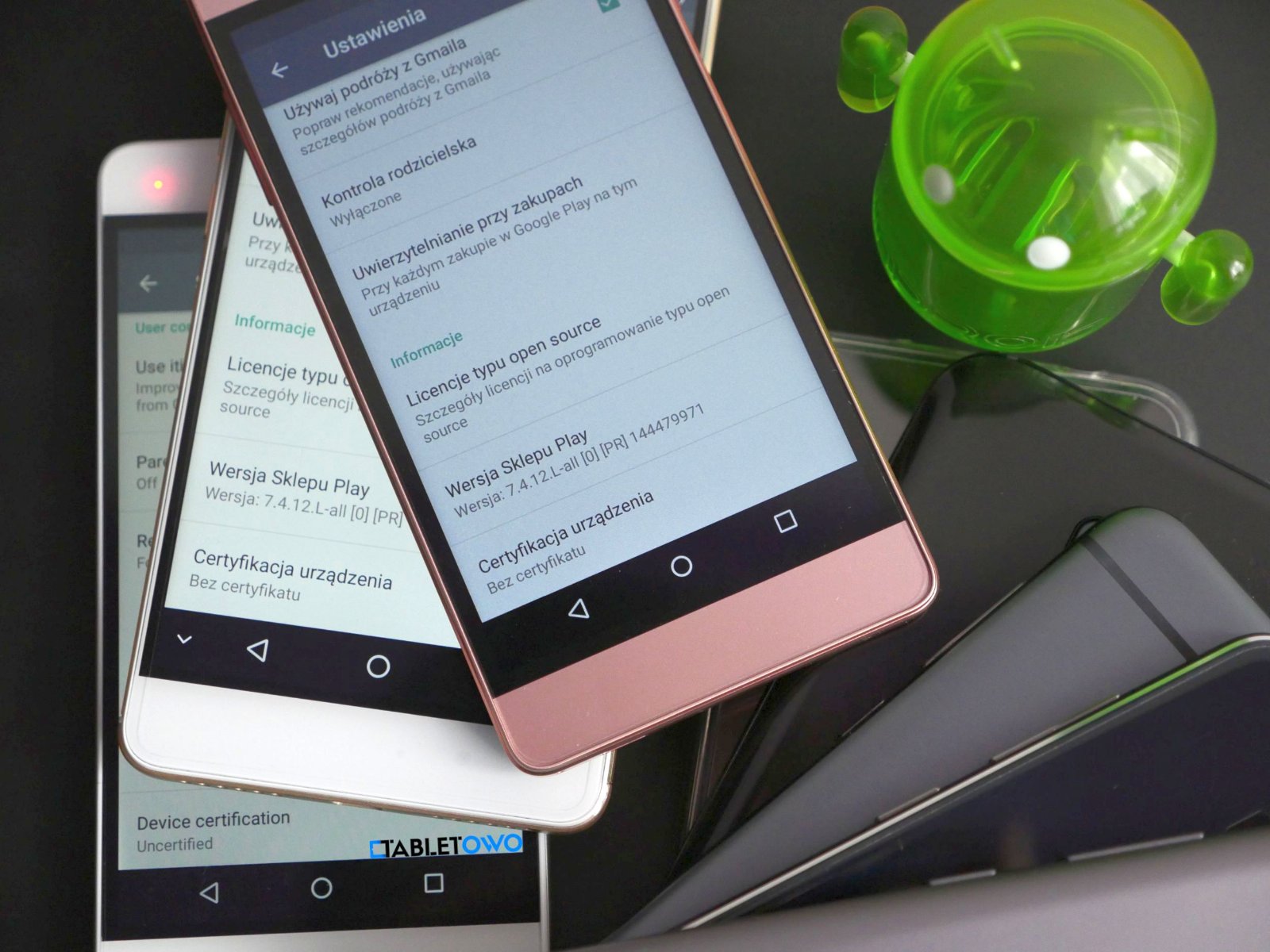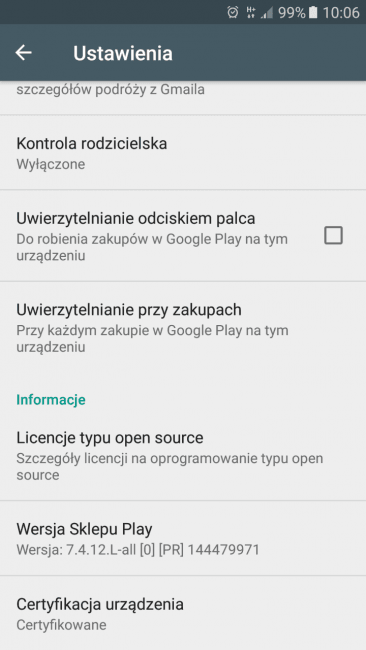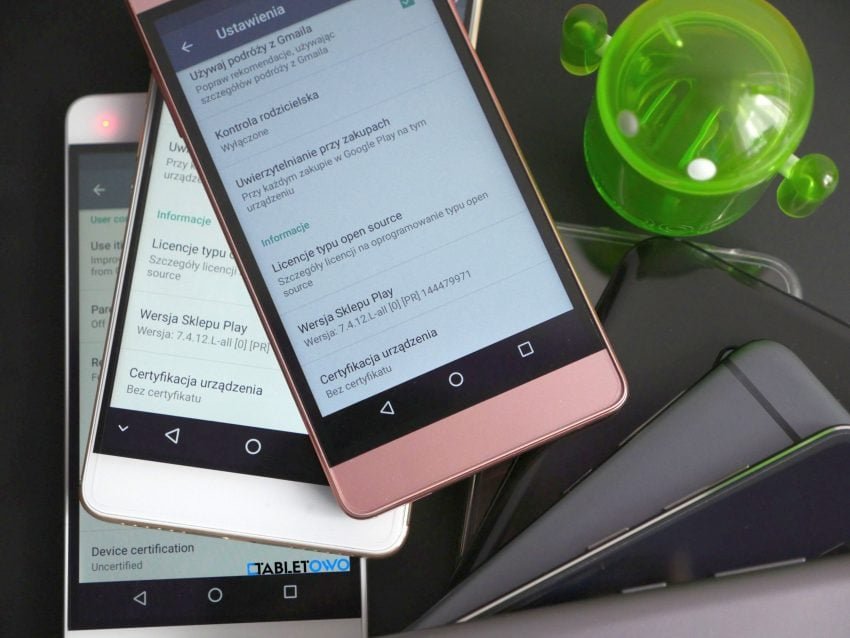Rynek smartfonów dojrzewa, sukcesywnie ewoluuje; zmienia się też podział sił pomiędzy poszczególnymi firmami. Do głosu coraz częściej dochodzą pomniejsze marki, o których istnieniu jeszcze kilka miesięcy temu nie mieliśmy bladego pojęcia. Ale wkrótce się to zmieni. Dotarliśmy do informacji, które raz na zawsze zmienią oblicze rynku smartfonów z Androidem. I to nie są żarty. Choć nie ukrywam, że sama, jak pierwszy raz usłyszałam to, o czym zaraz przeczytacie, stwierdziłam, że to absurd. Ale nie, to „najprawdziwsza prawda”. Okazuje się bowiem, że Google zrobi wszystko, by na rynku zostały jedynie te firmy, które grają z Google do jednej bramki. Przyszłość pozostałych… cóż, stoi pod znakiem zapytania. Wszystkiemu winna jest certyfikacja i GMS – zmora producentów smartfonów z Androidem.
Przychodzi prezes pomniejszego przedsiębiorstwa do Google. Zaczyna nieśmiało od drzwi: „Dostałem takie wezwanie i…”. „A, tak – proszę siadać” – odpowiada niezwłocznie mężczyzna siedzący za biurkiem. Nie czekając, aż prezes zajmie miejsce, człowiek w krawacie urzędniczym tonem oznajmia: „Mam dla Pana, panie prezesie, złe wieści. Wasze smartfony nie przeszły procesu certyfikacji. Oznacza to, że nie będziecie mogli instalować na swoich urządzeniach naszych aplikacji. Może to ostatecznie doprowadzić do upadku Pańskiej firmy za jakieś 10…” – głos mężczyzny na chwilę milknie. Prezes przerywa ciszę: „Ale 10 czego? Lat, miesięcy?”. Postać za biurkiem kontynuuje: „9… 8… 7… 6…”.
Normalne dla nas wydaje się, że kupując smartfon z Androidem, jedną z pierwszych czynności jest podpięcie do niego konta Google i zainstalowanie ze sklepu Google Play kilku najbardziej przydatnych aplikacji i narzędzi. A co jeśli nie byłoby to możliwe? Smartfon straciłby najważniejsze źródło pozyskiwania nowych programów, przez co dostęp do wielu usług mielibyśmy tylko i wyłącznie przez przeglądarkę internetową. Chyba nie muszę nikomu tłumaczyć, jak niewygodne bywa to rozwiązanie – zwykle korzystamy z niego w ostateczności.
Jednak taki scenariusz jest całkiem prawdopodobny, ponieważ Google wprowadza na całym świecie – w tym w naszym kraju – proces certyfikacji smartfonów. Co to takiego? Jak odbije się na producentach sprzętu i przede wszystkim na nas – konsumentach?
Na specjalnej stronie Google możemy dowiedzieć się nieco na temat certyfikacji urządzeń, prowadzonej przez tę firmę. Zostaje ona wprowadzona po to, by każde urządzenie z tym atestem, trafiające na rynek, miało gwarancję, że jest w stanie bezproblemowo „pociągnąć” sklep Google, podstawowe aplikacje oraz samego Androida.
Chodzi nie tylko o to, by zapewnić właścicielom smartfonów odpowiedni komfort i stabilność działania ich smartfonów. Google w ten sposób chce walczyć ze swojego rodzaju „szarą strefą”, która utworzyła się, odkąd prawie każdy może zlecić w Chinach wykonanie kilku tysięcy sztuk urządzeń wątpliwej jakości, zainstalować na nich Androida i sprzedawać jako sprzęt „wysokiego ryzyka”. Tak można określić urządzenie, które ma dostęp do sklepu Google, ale jego podzespoły i dodatkowe, śmieciowe oprogramowanie skutecznie przeszkadza czy nawet uniemożliwia normalne korzystanie z systemu i usług giganta z Mountain View.
Dlaczego to takie ważne dla producenta, żeby otrzymać certyfikat od Google?
Właściwie, dla niektórych pomniejszych producentów, będzie to kwestia typu: „być albo nie być”. Google oczywiście nie może żadnej firmie zabronić wypuszczania na rynek kiepskich urządzeń i instalowania na nich systemu Android, ponieważ jest to wolne oprogramowanie. Jednak kiedy firma produkująca smartfony nie nawiąże współpracy z Google i nie postara się o certyfikat, jej urządzenia stracą dostęp do sklepu Google.
Nie będzie możliwe też podpięcie do smartfonu swojego konta Google, więc korzystanie z jakichkolwiek usług internetowych będzie dla użytkownika urządzenia utrapieniem, a dostęp do niektórych z nich, świadczonych tylko przez aplikacje – stanie się niemożliwy. Być może w takim wypadku nawet instalacja aplikacji ze źródeł zewnętrznych (przez pliki .apk) też na niewiele się zda. Sporo z nich bazuje przecież na usługach Google’a.
W niektórych krajach (ale nie w Polsce) na smartfonie będzie się nawet pojawiać informacja, że urządzenie nie ma certyfikatu, z prośbą o skontaktowanie się z producentem, a nawet dyspozycją zwrócenia sprzętu do sklepu. Ma ona przybrać formę wyskakującego co jakiś czas na ekran monitu typu pop-up, co może skutecznie uprzykrzyć życie.
Jeśli tylko klienci zorientują się, że na smartfonach firmy „A” lub „B” nie będzie dało się korzystać ze sklepu Google Play, rynek szybko zweryfikuje obecność na nim b-brandów. Wobec fatalnej opinii, która rozejdzie się wśród internautów lotem błyskawicy, sprzedaż takich urządzeń spadnie do poziomu, który nie pozwoli tym przedsiębiorstwom czerpać realnych zysków. Rzecz jasna, producenci mniej popularnych smartfonów mają w swoim portfolio również szereg innych sprzętów, zatem niekoniecznie będzie to oznaczać rychły upadek ich firm, jednak na rynku smartfonów będą już one spisane na straty.
Na jakiej podstawie Google decyduje czy jakiemuś urządzeniu przyznać certyfikat, czy też nie?
Mówiąc wprost – testuje je. Zanim smartfon zostanie wprowadzony do sprzedaży, producent będący partnerem Google, wysyła do firmy pięć sztuk danego modelu. Są one gruntownie sprawdzane przez Google, w celu określenia, jak podzespoły współpracują z oprogramowaniem – czy Android jest dobrze zoptymalizowany i czy hardware nie sprawia problemów z poprawnym użytkowaniem aplikacji. Jeśli pojawiają się jakieś wątpliwości, egzemplarze są zwracane producentowi, a ten ma szansę wnieść poprawki. Następnie proces się powtarza, aż do momentu, w którym Google uzna działanie urządzenia za zadowalające. Proces ten jest żmudny i… kosztowny. Tak, za każdy element tego procesu firma musi zapłacić. I to całkiem spore pieniądze.
Wygląda to na straszną biurokrację, jednak Google chce być pewne, że smartfony, które będą miały wpływ na opinię o usługach firmy, są w stanie zapewnić ich użytkownikom optymalną płynność działania. Podobnie oddaje to też komentarz, który otrzymaliśmy prosto z Google Polska:
Naszym celem jest zapewnienie użytkownikom jak najbardziej stabilnego i przewidywalnego zachowania ich telefonów z Androidem wykorzystujących aplikacje Google. Użytkownicy mają teraz możliwość sprawdzenia statusu certyfikacji urządzenia w ustawieniach Google Play i dowiedzenia się, czy ich telefon ma odpowiednią licencję od firmy Google. Więcej informacji można znaleźć w tym artykule pomocy.
Jak mogę sprawdzić czy moje urządzenie ma certyfikat Google?
To akurat proste: otwieramy aplikację Sklepu Google w telefonie i z bocznej belki wybieramy „Ustawienia”. Tam na samym końcu listy, pod sekcją „Informacje”, znajdują się interesujące nas dane.
Które polskie firmy zadbały o certyfikację?
Z informacji, które do nas dotarły, możemy powiedzieć, że o certyfikat Google zadbały tylko trzy polskie firmy: Kiano (razem z własną submarką Cavion), MyPhone oraz Kruger&Matz. Żadni inni polscy producenci smartfonów nie mają certyfikatu i to już się nie zmieni.
Sporo osób jest jednak w posiadaniu urządzeń innych pomniejszych firm z Polski i Chin. Mam tu na myśli na przykład Goclever, Manta, Modecom, a z chińskich przede wszystkim: Ulefone, Bluboo, Umi czy Elephone. Na ich urządzeniach w ustawieniach Google Play pojawi się informacja, że certyfikatu brak.
Aktualizacja: Goclever zapewnia, że ich urządzenia nie stracą dostępu do usług Google. Od firmy otrzymaliśmy następujący komentarz: „firma Goclever pracuje w innym modelu biznesowym z Google – w ich imieniu certyfikuje dostawca urządzeń – czyli fabryka, w której kupują telefony. Firma zapewnia, że żadne z ich urządzeń nie straci możliwości z korzystania usług Google”.
Mam certyfikowane urządzenie – co mi to daje?
Dla niektórych to, czy Google sprawdziło wcześniej, że urządzenie jest kompatybilne z Androidem i umożliwia zadowalające działanie systemu, może nie mieć specjalnego znaczenia. Jednak niesie ze sobą wymierne korzyści.
Konsument zyskuje pewność, że jego sprzęt jest bezpieczny i będzie sprawny. Użytkownik nie zobaczy, jak aplikacje Google wysypują się do pulpitu, a sam system zalicza serie tragicznych zawieszek podczas wykonywania podstawowych czynności. Testy Google mają takie anomalie wychwycić. Jeśli producent zdecyduje się na wypuszczenie na rynek niecertyfikowanego urządzenia, zadziała na własną niekorzyść.
Co ważniejsze: certyfikacja umożliwia otrzymywanie aktualizacji do wyższych wersji systemu oraz poprawek bezpieczeństwa. Oczywiście to, czy jakiś smartfon dostanie kolejną edycję Androida, będzie nadal zależeć od producenta, jednak w przypadku braku certyfikatu, nie będzie to możliwe w ogóle. Zatem kupując niecertyfikowane urządzenie, skażemy się na brak jakichkolwiek aktualizacji systemu – chyba, że dokonamy ich manualnie, instalując sobie nowszego Androida „na piechotę”.
Ktoś mógłby powiedzieć: „Ale to już od początku jest jasne, że jeśli ktoś kupuje jakiegoś chińskiego no-nejma, to nie może liczyć na aktualizacje systemu”. Prawda. Tylko, że dotąd niemal każdy taki sprzęt miał dostęp do aplikacji przez sklep Google Play. Po wprowadzeniu obostrzeń dla niecertyfikowanych urządzeń, smartfony zostaną na zawsze odcięte od konta Google. Wtedy smartfon przestanie być już taki „smart”.
Zresztą, już teraz na stronie Google możemy przeczytać:
Jeśli urządzenie jest niecertyfikowane, oznacza to, że Google nie ma wyników testów zgodności tego urządzenia z Androidem.
Pamiętaj, że:
-
urządzenia niecertyfikowane mogą nie być bezpieczne,
-
urządzenia niecertyfikowane mogą nie pobierać aktualizacji systemu Android ani aktualizacji aplikacji,
-
aplikacje Google na urządzeniach niecertyfikowanych nie są licencjonowane i mogą nie być prawdziwymi aplikacjami Google,
-
aplikacje i funkcje na urządzeniach niecertyfikowanych mogą nie działać poprawnie,
-
urządzenia niecertyfikowane mogą nie tworzyć kopii zapasowych danych w bezpieczny sposób.
Kiedy spodziewać się zmian?
Na pewno uzyskamy jeszcze na ten temat dokładniejsze informacje, jednak już teraz wiemy, że począwszy od drugiego kwartału bieżącego roku na niecertyfikowanych urządzeniach pojawi się stosowna informacja, a smartfony stracą możliwość korzystania z aplikacji Google wraz z trzecim kwartałem.
Widać więc, że firma nie próżnuje i efekty podjętych działań będą widoczne już wkrótce.
Jak to wpłynie na rynek smartfonów w Polsce?
Na pewno nie wywróci go do góry nogami. Smartfony Samsunga, LG, Huawei, Xiaomi i innych popularnych w naszym kraju producentów naturalnie stosowny certyfikat mają i tu nic nie podlega dyskusji. Większość ich użytkowników może nawet nie będzie świadomych istnienia czegoś takiego jak certyfikacja Google.
Jednak działania te mogą spowodować całkowite wycofanie z rodzimego rynku smartfonów i tabletów z Androidem takich firm jak Goclever czy Manta. Po głowie dostaną też dystrybutorzy Umi czy Ulefone. Klienci stracą możliwość kupowania ich smartfonów lub będą to robić z pełną świadomością, że funkcjonalność tych telefonów zostanie silnie ograniczona.
Dla nas – konsumentów, to dobre wieści. Niedługo decydując się na zakup tańszego urządzenia, którego producent nie każe płacić sobie tak dużo za swoje logo na obudowie, nie będziemy raz po raz zastanawiać się czy Gmail będzie na nim płynnie działał. Certyfikacja rozwieje wątpliwości – przynajmniej te dotyczące oprogramowania.
Nasze polskie firmy, takie jak Kiano, Kruger&Matz czy MyPhone, też powinny być zadowolone. Dzięki partnerstwu z Google nie tylko będą lepiej wyglądać w branżowej prasie, ale też zyskają nieco miejsca w robiącym się ostatnio coraz bardziej ciasnym, krajowym segmencie b-brandów. Jeśli brak certyfikatów przyznawanych niektórym producentom przyczyni się do zmniejszenia konkurencji na polu tańszych smartfonów, to wspomniane firmy tylko na tym zyskają.
Podsumowując (TL;DR),
- od 1 lutego w Google Play każdy może sprawdzić czy jego urządzenie jest certyfikowane przez Google (Google Play -> Ustawienia -> Certyfikacja),
- z polskich firm certyfikację mają wyłącznie te firmy: Kiano (+ Cavion), Kruger&Matz oraz myPhone,
- począwszy od Q3 2017 wszystkie świeżo aktywowane, a niecertyfikowane smartfony, stracą dostęp do Google Play oraz usług Google,
- listę wszystkich firm mających certyfikację GMS można znaleźć na stronie Google,
- działania, o których mowa w niniejszym artykule, mają na celu wyeliminowanie z rynku urządzeń niecertyfikowanych, których Google nie jest pewne, a także tych, które „obchodzą” proces certyfikacji. Ma to również na celu stawianie na pierwszym planie firm, które od obowiązku certyfikacji się nie uchylają oraz blisko współpracują z Google.
Czy wasze smartfony mają certyfikat Google?
_
Wielkie podziękowania dla moich informatorów, bez których nie powstałby ten tekst, jak również dla Karola, który ów tekst przygotował na podstawie uzyskanych przeze mnie informacji.
[wpsm_toggle title=”English version below”]
The smartphone market matures, gradually evolving; the division of power between the individual companies also changes, as well as the presence of smaller brand, the existence of which we had no clue a few months ago. But soon this will change. We got the information that forever change the smartphone market with Android. And this is no joke. Although I admit that the first time I heard it, I thought that it’s an absurd. But no, it’s „the truest truth”. It turns out that Google will do everything to keep on the market only those companies which are aiming to the same goal. The future of the other … well, is questionable. Everything is about the certification and GMS.
The president of minor enterprise comes to Google. He begins shyly from the door: „I got a call and …”. „Ah, yes – please sit down” – responds immediately the man sitting behind the desk. But he don’t wait until the president takes the place, the man in the tie declares: „I have for you, Mr. president, the bad news. Your smartphone does not have passed the certification process. This means that you will not be able to install our applications on your devices. This may eventually lead to the collapse of your company in about 10 … „- man’s voice falls silent for a moment. President breaks the silence: „But 10 what? Years, months? „. The figure behind the desk continues: „9 … 8 … 7 … 6 …”.
It seems normal for us after buying Android smartphone, that the first step is logging in into our Google account and installing some of the most useful applications and tools from the Google Play store. What if it would not be possible? Smartphone lose the most important source for new programs, making access to many services only via a web browser. I do not think I need to explain to anyone how uncomfortable that is.
However, such a scenario is quite likely, since Google introduced around the world – including in our country – the certification process smartphones. What is that? How will affect manufacturers of equipment and all of us – consumers?
On a special page in Google’s servers, we can learn a little about the device certification, conducted by this company. It is conducted to be sure that each device with this certificate, coming onto the market, would guarantee that it is able to seamlessly „pull” store Google, basic applications and the Android.
But providing „enough” level of stability of smartphones isn’t only purpose. Google also wants to fight with a kind of „gray zone” that formed since almost anyone can outsource the execution of several thousand pieces of equipment of questionable quality in China, install Android on it and sell it as the „high risk equipment.” Yes, you can name that way a device that has access to the Google Play store, but its components and additional junk software effectively hinders or even prevents the normal use of the system and services.
Why is it important for the manufacturer to receive certification from Google?
Actually, for some smaller manufacturers, it will be a question of type: „to be or not to be.” Google obviously can not prohibit any company release to the market of bad devices and install them on Android, because it is free software. But when a company manufacturing smartphones fails to engage with Google and didn’t manage to get the certification, the device will lose access to the Google Play store .
There will also be impossible to equip your smartphone with your Google account , so using any Internet service will be for the user nuisance, and access to some of them, provided only by the applications – will become impossible. Perhaps, in this case, even installing applications from external sources (via the .apk files) won’t bring the expected effect, because a lot of them is based on Google’s services.
In some countries (but not in Poland) on the smartphone will even appear an pop up information that the device is not certified, with a request to contact the manufacturer, or even the disposition to return the equipment to the store.
When customers realize that smartphones from the company „A” or „B” will not be allowed to use the Google Play store, the market quickly verify the presence of that b-brands. After terrible reviews, which will spread like wildfire among Internet users, sales of these devices will fall to a level that does not allow the companies to reap real benefits. Of course, manufacturers of less popular smartphones have in their portfolio a range of other equipment, therefore, it will not necessarily mean the imminent collapse of their companies, but on the smartphone market they won’t play more.
How Google will decide which device will get the certificate, or not?
Three words – by testing them. Before the smartphone launch, manufacturer should send five units of new model to Google. Devices will be tested by Google to determine how the components interact with software – whether Android is well optimized and if the hardware does not cause problems with the proper use of the application. If there are any doubts, devices are returned to the manufacturer, and he will get a chance to make corrections. The process will repeat until the Google will be fully satisfied. But this process is tedious and expensive …. So, for every element of this process, the company must pay. And it’s quite a lot of money.
It looks like a terrible bureaucracy, but Google wants to be sure that smartphones, which will have an impact on the opinion about the company’s services, are able to provide their users an optimum smoothness of operation. Likewise, it also reflects the comments that we received directly from Google Poland:
Our goal is to provide users with the most stable and predictable behavior of their phones with Android using Google applications. Users can check the certification status of devices in the Google Play settings and find out if their phone has the appropriate license from Google. More information can be found in this help article .
How can I check if my device is certified Google?
It’s just simple: open the Google Play Store app and from the hamburger menu choose „Settings”. There, at the very end of the list, under the section „Information”, are interesting data.
Polish company that took care of certification?
From the information that reached us, we can say that only three Polish companies took care of Google’s certficiation: Kiano (together with its own sub-brand Cavion), MyPhone and Kruger & Matz . No other Polish manufacturers do not have a certificate and it has not changed.
Many people, however, is in possession of devices from other smaller Polish and Chinese companies. I mean, for example, Goclever, Manta, Modecom, and China in particular: Meizu, Ulefone, Bluboo, Umi and Elephone. In devices from those manufacturers in Google Play store information we will see that they don’t have the certificat.
I have a certified device – what does it mean for me?
For some users it won’t be meaningfull if their device has the certificat or not. However, for everyone it brings tangible benefits.
The consumer is assured that the equipment is safe and will be fully functional. You do not see Google applications „shedding” to the desktop, and the system have a series of tragic hooks while performing basic operations. Google’s tests will catch that kind of things.
Certification also allows you to receive upgrade to higher versions and security patches. Of course, whether a smartphone will receive the next edition of Android, will still depends on the manufacturer, but in the absence of a certificate, it will not be possible at all. So buying uncertified device, we condemned for the lack of any system upgrade – unless we make them manually installing a newer Android „on foot”.
Someone might say: „But from the beginning it is clear that if someone buys a smartphone from a small Chinese firm, it won’t get system updates.” Truth. But till today almost all the equipment had access to applications through the Google Play store. After the introduction of restrictions for non-certified devices, smartphones will be forever cut off from your Google account. So smartphone no longer will be „smart”.
Anyway, now at Google’s website, we read:
If the device is a non-certified, this means that Google does not have the results of compatibility tests of Android devices.
Remember that:
-
non-certified devices may not be safe,
-
non-certified devices can not download updates Android or application update
-
Google applications on uncertified devices are not licensed and may not be true Google’s applications,
-
applications and features on uncertified devices may not work correctly,
-
non-certified devices can not back up data in a secure manner.
When we expect changes?
Certainly we will get more accurate information, in the nearest, but now we know that from the second quarter of this year, on non-certified devices will be displayed relevant information, and smartphones will lose the ability to use Google’s applications along with the third quarter.
So you can see that the company is not idle, and the effects of the taken actions will be visible soon.
How this will affect the smartphone market in Poland?
Smartphones from Samsung, LG, Huawei, Xiaomi and other popular manufacturers in our country naturally have an appropriate certificate. Most of their users may not even be aware of the existence of something like „Google certification”.
However, these actions can result in the complete withdrawal from the domestic market of smartphones and Android tablets from companies such as Goclever or Manta. It also affect Umi or Ulefone distributors. Customers will lose the opportunity to buy their smartphones or will do so with full knowledge that the functionality of these phones will be severely limited.
For us – the consumers, it is good news. Soon if someone will decide to purchase less expensive equipment, he or she won’t wonder whether i.e. Gmail will work smoothly on it. Certification will dispel any doubts – at least in terms of software.
Our Polish companies such as Kiano, Kruger & Matz or MyPhone, they should be happy. By partnering with Google will not only look better in the trade press, but also gain some space in the domestic b-brands segment. Which is really tight in Poland. If the lack of granted certificates will contribute to the reduction of competition in the field of cheaper smartphones, that companies only will gain.
In summary (TL; DR):
- from 1 February in Google Play anyone can check if the device is certified by Google (Google Play -> Settings -> Certification)
- only those polish companies have appropriate certification: Kiano (+ Cavion), Kruger & Matz and myPhone.
- from Q3 2017 all newly-activated and non-certified smart phones, will lose access to Google Play and Google services
- a list of all companies having the certification of GMS can be found on Google’s website ,
- actions referred in this article is intended to eliminate uncertified devices from the market, which Google is not sure, as well as those who „get around” the certification process. This is also aimed at putting in the foreground companies that have the certificats and work closely with Google.
[/wpsm_toggle]




